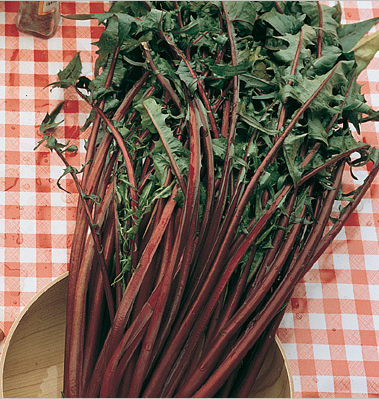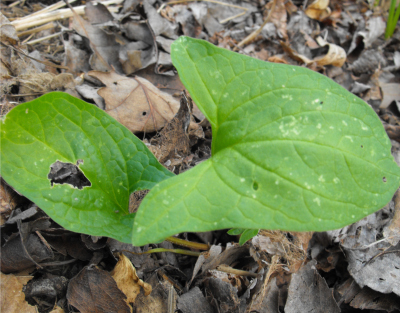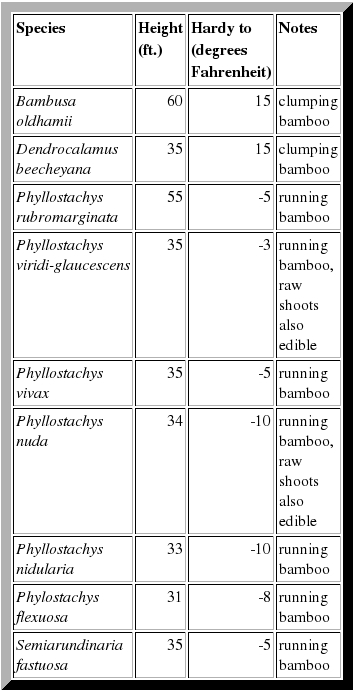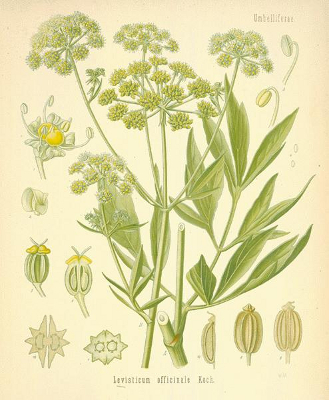
Perennial vegetables for spring greens
 The main niche that I would
like perennial vegetables to fill in our diet is extending the fresh
greens season to the early spring. While I read Eric Toensmeier's
Perennial Vegetables, I kept jotting down notes
on species that might fill that niche, and here are the top contenders.
The main niche that I would
like perennial vegetables to fill in our diet is extending the fresh
greens season to the early spring. While I read Eric Toensmeier's
Perennial Vegetables, I kept jotting down notes
on species that might fill that niche, and here are the top contenders.
Chicory (aka Italian Dandelion, Cicorium
intybus) and Dandelion
(aka French Dandelion Taraxacum
officinale) are
currently at the top of my list for perennial spring greens. Both
are popular in Europe as salad or cooked greens, and after my
experience last spring with dandelions, I can see why. Like other
perennial greens, the leaves are ready much earlier in the year than
any annuals you can grow, although you will probably give up on eating
chicory and dandelion for the season once they bloom and the leaves
turn bitter. (Pick off flowers and blanch the leaves by piling
mulch on them for a longer harvest season.) You can easily find
dandelions and chicory in the wild, but I suspect that the cultivated
versions are even tastier, so I plan to buy some seeds and give them a
shot this year. Both species are easy to grow from seed, and
should be planted a foot apart in full sun or light shade. The
most difficult part seems to be wading through seed catalogs in search
of varieties that are perennial, since annual and biennial versions of
chicory exist (although all French Dandelions are perennials.)
 Good King Henry (Chenopodium
bonus-henricus)
is probably mentioned more than any other perennial vegetable in
permaculture texts. (Well, except for rhubarb and asparagus,
which are both so common I'm not talking about them in this lunchtime
series.) Good King Henry is primarily grown for its edible shoots
(think asparagus), which poke out of the ground three weeks before
asparagus is visible and extend for a three month season. If this
glut is not enough, leaves, young flower clusters, and seeds are also
edible, although it sounds like the last need to be soaked overnight
and none of the three are taste-test winners. Seeds or root
divisions are planted 18 to 24 inches apart, and the shoots are
harvested beginning in the second year. A friend gave me a start
of Good King Henry last spring, which I
planted in the forest garden island and promptly forgot about in
the bustle of the annual vegetable garden. If it survived the
neglect, we might be able to taste a few leaves this spring.
Good King Henry (Chenopodium
bonus-henricus)
is probably mentioned more than any other perennial vegetable in
permaculture texts. (Well, except for rhubarb and asparagus,
which are both so common I'm not talking about them in this lunchtime
series.) Good King Henry is primarily grown for its edible shoots
(think asparagus), which poke out of the ground three weeks before
asparagus is visible and extend for a three month season. If this
glut is not enough, leaves, young flower clusters, and seeds are also
edible, although it sounds like the last need to be soaked overnight
and none of the three are taste-test winners. Seeds or root
divisions are planted 18 to 24 inches apart, and the shoots are
harvested beginning in the second year. A friend gave me a start
of Good King Henry last spring, which I
planted in the forest garden island and promptly forgot about in
the bustle of the annual vegetable garden. If it survived the
neglect, we might be able to taste a few leaves this spring.
 Bamboo shoots are more of a texture
addition to meals than a nutrient powerhouse, but since the plants are
useful for so many other things, I decided to plant a species that
provides shoots as well. If you want to cultivate edible bamboo,
your first choice is between clumping bamboos, which have more and
bigger shoots and won't take over your garden, but which also need
warmer temperatures, or running bamboos, which will definitely take
over your garden, are sometimes hardy as low as -10 degrees Fahrenheit,
and make smaller shoots that are considered by some to be
tastier. The chart to the right lists the size, hardiness, and
edibility of the top bamboo species --- Toensmeier profiles several
more in his book, but I've excerpted the bamboos that make the largest
stalks (aka "timber bamboos"), will survive in our climate, and are
listed in his book as having excellent flavor. In terms of
hardiness, zone 6 can get as low as -10 degrees Fahrenheit, but I
suspect that most or all of these bamboo species will grow here since
the temperatures listed are simply those at which the leaves die.
With a good mulch cover, your bamboo will come back from the roots even
if the entire cane freezes during a cold winter. To harvest and
eat bamboo shoots, pick them when they are just barely poking through
the soil, remove the leafy sheath, boil, and then use the pre-cooked
shoots in stir-fries.
Bamboo shoots are more of a texture
addition to meals than a nutrient powerhouse, but since the plants are
useful for so many other things, I decided to plant a species that
provides shoots as well. If you want to cultivate edible bamboo,
your first choice is between clumping bamboos, which have more and
bigger shoots and won't take over your garden, but which also need
warmer temperatures, or running bamboos, which will definitely take
over your garden, are sometimes hardy as low as -10 degrees Fahrenheit,
and make smaller shoots that are considered by some to be
tastier. The chart to the right lists the size, hardiness, and
edibility of the top bamboo species --- Toensmeier profiles several
more in his book, but I've excerpted the bamboos that make the largest
stalks (aka "timber bamboos"), will survive in our climate, and are
listed in his book as having excellent flavor. In terms of
hardiness, zone 6 can get as low as -10 degrees Fahrenheit, but I
suspect that most or all of these bamboo species will grow here since
the temperatures listed are simply those at which the leaves die.
With a good mulch cover, your bamboo will come back from the roots even
if the entire cane freezes during a cold winter. To harvest and
eat bamboo shoots, pick them when they are just barely poking through
the soil, remove the leafy sheath, boil, and then use the pre-cooked
shoots in stir-fries.
 Finally, Lovage (Levisticum
officinale) looks
like it might be a good addition to our anti-celery garden. I
really enjoy adding celery to soups and salads, but find that the
vegetable is very difficult to grow in our garden. Instead, I
plant lots of parsley, which has a similar taste and grows much better
for me. Lovage seems to fit into the same celery-alternative
category, especially in the spring before the plant becomes too
strongly flavored for normal consumption. To grow lovage, start
the plants from seed or by divisions of fully dormant plants and set
them out where the six foot flower stalks won't cause problems.
Enjoy the greens very early in the spring, blanching them with mulch
for a milder flavor.
Finally, Lovage (Levisticum
officinale) looks
like it might be a good addition to our anti-celery garden. I
really enjoy adding celery to soups and salads, but find that the
vegetable is very difficult to grow in our garden. Instead, I
plant lots of parsley, which has a similar taste and grows much better
for me. Lovage seems to fit into the same celery-alternative
category, especially in the spring before the plant becomes too
strongly flavored for normal consumption. To grow lovage, start
the plants from seed or by divisions of fully dormant plants and set
them out where the six foot flower stalks won't cause problems.
Enjoy the greens very early in the spring, blanching them with mulch
for a milder flavor.
| This post is part of our Perennial Vegetables lunchtime series.
Read all of the entries: |
Want more in-depth information? Browse through our books.
Or explore more posts by date or by subject.
About us: Anna Hess and Mark Hamilton spent over a decade living self-sufficiently in the mountains of Virginia before moving north to start over from scratch in the foothills of Ohio. They've experimented with permaculture, no-till gardening, trailersteading, home-based microbusinesses and much more, writing about their adventures in both blogs and books.
Want to be notified when new comments are posted on this page? Click on the RSS button after you add a comment to subscribe to the comment feed, or simply check the box beside "email replies to me" while writing your comment.

I've got some bambusa oldhamii in a pot, waiting to be planted out. Or more correctly, waiting for me to figure out where it can grow without becoming a nuisance!
I'm growing it mainly for the bamboo poles for construction (garden fences, shelters, cubby houses, bird net supports, plant trellises, etc), but it's good to know the shoots are edible as well.
I visited a property on the weekend that had a running bamboo that was out of control, and it's made me resolute that I'm only going to plant clumping varieties! I cut some poles from the bamboo patch to use around my garden, but there is a huge amount still there and it grows so fast that it's practically impossible to control.
Interesting that Bambusa oldhamii seems to be the bamboo of choice for both of you. Maybe because it's the tallest one often available? I didn't even consider it because it's only hardy down to 15, but I suspect it'll do well in both of your climates. If you taste the shoots, I'd be very curious to hear what you think of them!
Darren --- My understanding is that none of the clumping bamboos will become a nuisance. They're not supposed to reach beyond about 6 feet from the center of the clump in any direction. I think that if you plant a running bamboo (like we plan to) without a rhizome barrier, you need to set it aside where you don't care if it runs a long way, and plan to cut it hard and often.
Shannon --- It may grow slower than a running variety, but I suspect it'll make a good barrier once it gets situated!
From what I've seen of mature Oldhamii, I'd be that 60' is conservative. That stuff must be 12" diameter... or at least the source for my clones was.
I'm a bit worried about soil quality and drainage where I planted mine. It's mostly clay, though it is a bit better drained than the soil about 20' from where I planted it. I'll have to take a look tomorrow and see how it is doing as it's on the very back of my acreage and I don't pass by there much in the winter.
Shannon --- wow! That's a real timber bamboo! I'll bet you could build a house out of it! You'll have to let me know how it's doing in your clay soil once you check on it.
Daddy --- fascinating ideas! A quick search of the internet suggests that, when burning bamboo, you have to first cut through the nodes so the pockets of moist air don't cause the bamboo to explode when heated. People suggest that it burns hot and fast and is primarily useful as kindling. Some people are turning bamboo into charcoal and then burning it that way. Others suggest that bamboo is a very good fuel for rocket stoves, which is actually the use that sounds most enticing, given all of that info.
http://bioenergy.ornl.gov/reports/misc/bamboo.html says: "There is little evidence overall that bamboo is significantly more productive than many other candidate bioenergy crops, but it shares a number of desirable fuel characteristics with certain other bioenergy feedstocks, such as low ash content and alkali index. Its heating value is lower than many woody biomass feedstocks but higher than most agricultural residues, grasses and straws."